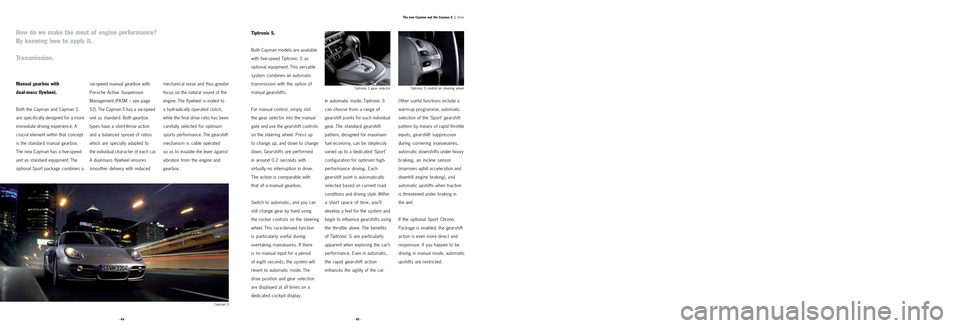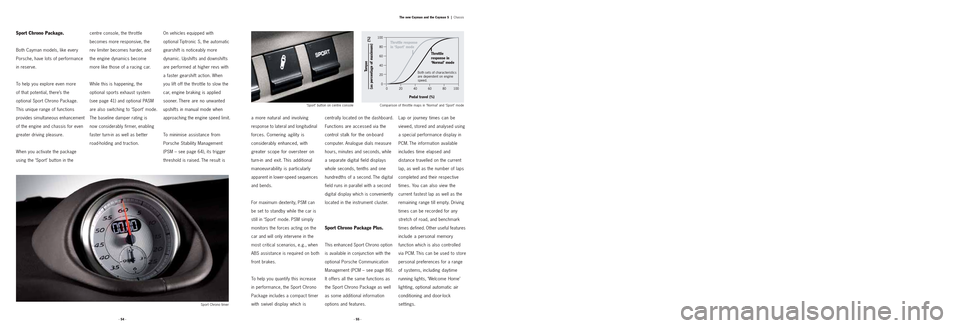traction control PORSCHE CAYMAN 2006 1.G Information Manual
[x] Cancel search | Manufacturer: PORSCHE, Model Year: 2006, Model line: CAYMAN, Model: PORSCHE CAYMAN 2006 1.GPages: 61, PDF Size: 2.24 MB
Page 21 of 61

· 45 · · 44 ·
Tiptronic S.
Both Cayman models are available
with five-speed Tiptronic S as
optional equipment. This versatile
system combines an automatic
transmission with the option of
manual gearshifts.
For manual control, simply slot
the gear selector into the manual
gate and use the gearshift controls
on the steering wheel. Press up
to change up, and down to change
down. Gearshifts are performed
in around 0.2 seconds with
virtually no interruption in drive.
The action is comparable with
that of a manual gearbox.
Switch to automatic, and you can
still change gear by hand using
the rocker controls on the steering
wheel. This race-derived function
is particularly useful during
overtaking manoeuvres. If there
is no manual input for a period
of eight seconds, the system will
revert to automatic mode. The
drive position and gear selection
are displayed at all times on a
dedicated cockpit display.
In automatic mode, Tiptronic S
can choose from a range of
gearshift points for each individual
gear. The standard gearshift
pattern, designed for maximum
fuel economy, can be steplessly
varied up to a dedicated ‘Sport’
configuration for optimum high-
performance driving. Each
gearshift point is automatically
selected based on current road
conditions and driving style. Within
a short space of time, you’ll
develop a feel for the system and
begin to influence gearshifts using
the throttle alone. The benefits
of Tiptronic S are particularly
apparent when exploring the car’s
performance. Even in automatic,
the rapid gearshift action
enhances the agility of the car.
The new Cayman and the Cayman S |Drive
Manual gearbox with
dual-mass flywheel.
Both the Cayman and Cayman S
are specifically designed for a more
immediate driving experience. A
crucial element within that concept
is the standard manual gearbox.
The new Cayman has a five-speed
unit as standard equipm
ent. The
optional Sport package combines a
How do we make the most of engine performance?
By knowing how to apply it.
Transmission.
mechanical noise and thus greater
focus on the natural sound of the
engine. The flywheel is mated to
a hydraulically operated clutch,
while the final drive ratio has been
carefully selected for optimum
sports performance. The gearshift
mechanism is cable operated
so as to insulate the lever against
vibration from the engine and
gearbox.
Other useful functions include a
warm-up programme, automatic
selection of the ‘Sport’ gearshift
pattern by means of rapid throttle
inputs, gearshift suppression
during cornering manoeuvres,
automatic downshifts under heavy
braking, an incline sensor
(improves uphill acceleration and
downhill engine braking), a nd
automatic upshifts when traction
is threatened under braking in
the wet.
If the optional Sport Chrono
Package is enabled, the gearshift
action is even more direct and
responsive. If you happen to be
driving in manual mode, automatic
upshifts are restricted.
six-speed manual gearbox with
Porsche Active Suspension
Management (PASM – see page
52). The Cayman S has a six-speed
unit as standard. Both gearbox
types have a short-throw action
and a balanced spread of ratios
which are specially adapted to
the individual character of each car.
A dual-mass flywheel ensures
smoother delivery with reduced
Tiptronic S gear selector Tiptronic S control on steering wheel
Cayman S
Page 25 of 61

· 53 · · 52 ·The new Cayman and the Cayman S |
Chassis
Porsche Active Suspension
Management (PASM).
PASM is an electronic damping
control system. Available on
both Cayman models, it offers
continuous adjustment of
individual damping forces based
on current road conditions and
driving style. Agility and driving
pleasure are significantly
enhanced while retaining the
car’s natural ride quality. Equipped
with PASM, the car rides 10 mm
lower than with the standard
steel-sprung suspension.
The driver can choose one of
two setup modes, ‘Normal’ or
‘Sport’. While the first is a blend
of performance and comfort, the
‘Sport’ setup ratings are generally
much firmer, enabling greater
agility on the racetrack. In either
mode, the system responds to
changing loads by automatically
applying the optimum damping
rate on each individual wheel.
The rates are selected from a
range of map options which are
specially adapted to the unique
dynamics of the Cayman and
Cayman S.
The movement of the body is
continuously monitored under
acceleration, braking and cornering
manoeuvres, as well as on poor
road surfaces. Other sensors
provide additional information on
lateral acceleration, steering
angle, brake pressure and engine
torque. A dedicated control unitprovides real-time analysis and
damper adjustment as defined
for the respective setup mode
(‘Normal’ or ‘Sport’). The result:
greater stability and more
consistent occupant comfort.
If, when ‘Sport’ mode is selected,
the quality of road surface drops
below a certain threshold, the
system immediately switches
to
a softer rating and restores
the car’s traction and grip.
When the road surface improves,
PASM returns to the original,
harder ratings. The system
remains active in ‘Normal’ mode,
too, automatically switching to a
harder setup if the car is driven
more assertively. As the dampers
become stiffer, the car becomes
more stable and driver control is
improved.
Rebound in ‘Normal’ mode –
damper piston with bypass
valve openRebound in ‘Sport’ mode –
damper piston with bypass
valve closed
Compression in ‘Sport’ mode –
damper piston with bypass
valve closed Compression in ‘Normal’ mode –
damper piston with bypass
valve open
Page 26 of 61

· 54 ·The new Cayman and the Cayman S |
Chassis
a more natural and involving
response to lateral and longitudinal
forces. Cornering agility is
considerably enhanced, with
greater scope for oversteer on
turn-in and exit. This additional
manoeuvrability is particularly
apparent in lower-speed sequences
and bends.
For maximum dexterity, PSM can
be set to standby while the car is
still in ‘Sport’ mode. PSM simply
monitors the forces acting on the
car and will only intervene in the
most critical scenarios, e.g., when
ABS assistance is required on both
front brakes.
To help you quantify this increase
in performance, the Sport Chrono
Package includes a compact timer
with swivel display which is
centrally located on the dashboard.
Functions are accessed via the
control stalk for the on-board
computer. Analogue dials measure
hours, minutes and seconds, while
a separate digital field displays
whole seconds, tenths and one
hundredths of a second. The digital
field runs in parallel with a second
digital display which is conveniently
located in the instrument cluster.
Sport Chrono Package Plus.
This enhanced Sport Chrono option
is available in conjunction with the
optional Porsche Communication
Management (PCM – see page 86).
It offers all the same functions as
the Sport Chrono Package as well
as some additional information
options and features.
‘Sport’ button on centre console
Lap or journey times can be
viewed, stored and analysed using
a special performance display in
PCM. The information available
includes time elapsed and
distance travelled on the current
lap, as well as the number of laps
completed and their respective
times. You can also view the
current fastest lap as well as the
remaining range till empty. Driving
times can be recorded for any
stretch of road, and benchmark
times defined. Other useful features
include a personal memory
function which is also controlled
via PCM. This can be used to store
personal preferences for a range
of systems, including daytime
running lights, ‘Welcome Home’
lighting, optional automatic air
conditioning and door-lock
settings.
· 55 ·
Sport Chrono Package.
Both Cayman models, like every
Porsche, have lots of performance
in reserve.
To help you explore even more
of that potential, there’s the
optional Sport Chrono Package.
This unique range of functions
provides simultaneous enhancement
of the engine and chassis for even
greater driving pleasure.
When you activate the package
using the ‘Sport’ button in the
Throttle response
in ‘Sport’ mode
Throttle
response in
‘Normal’ mode
Both sets of characteristics
are dependent on engine
speed.
Pedal travel (%)
(%) Torque
(as percentage of maximum)
Comparison of throttle maps in ‘Normal’ and ‘Sport’ mode
centre console, the throttle
becomes more responsive, the
rev limiter becomes harder, and
the engine dynamics become
more like those of a racing car.
While this is happening, the
optional sports exhaust system
(see page 41) and optional PASM
are also switching to ‘Sport’ mode.
The baseline damper rating is
now considerably firmer, enabling
faster turn-in as well as better
road-holding and traction.On vehicles equipped with
optional Tiptronic S, the automatic
gearshift is noticeably more
dynamic. Upshifts and downshifts
are performed at higher revs with
a faster gearshift action. When
you lift off the throttle to slow the
car, engine braking is applied
sooner. There are no unwanted
upshifts in manual mode when
approaching the engine speed limit.
To minimise assistance from
Porsche Stability Management
(PSM – see page 64), its trigger
threshold is raised. The result is
Sport Chrono timer
Page 31 of 61

· 64 ·The new Cayman and the Cayman S |
Safety
it can never suspend the laws of
physics, PSM does provide that
extra margin of safety whenever
you need it most. A key component
in PSM is a specially optimised
anti-lock braking system (ABS)
offering safer deceleration and
shorter braking distances. PSM
is also invaluable when applying
the throttle on low-grip surfaces.
Here, it uses the ABD (automatic
brake differential) and ASR
(anti-slip regulation) functions to
maintain traction and stability.
In order to retain the car’s natural
agility, PSM combines a high
trigger threshold with precision
input characteristics.
Porsche Stability
Management (PSM).
This automatic vehicle stability
control system is standard
equipment on both Cayman
models. Throughout each journey,
PSM uses a range of sensors to
monitor the direction, speed, yaw
velocity and lateral acceleration
of the car. Using this information,
it is possible to calculate the
actual direction of travel at any
given moment. If the car begins
to oversteer or understeer,
PSM applies selective braking on
individual wheels to restore
stability and optimum speed. WhileThe PSM threshold is raised
higher still when ‘Sport’ mode is
selected on the optional Sport
Chrono Package/Sport Chrono
Package Plus. The resulting
drive is much more involving,
particularly at speeds up to
around 70 km / h (44 mph). If
you’d rather enjoy the car
unassisted, the system can be set
to standby. When ‘Sport’ mode is
selected, PSM will only intervene
under heavy braking where both
front wheels are in danger of
locking. In ‘Normal’ mode, PSM
automatically becomes active
as soon as one of the front
wheels requires ABS assistance.The upper section of each door
features additional reinforcements
(3) which enhance the rigidity of
the car. This upper load path (4)
is used to channel energy into
the side of the car and thus
provide additional protection for
the passenger cell.
Passive safety.
Both Cayman models easily
comply with all statutory
requirements in respect of frontal,
side, diagonal, rear impact and
rollover protection.
The bodyshell structure contains
a highly resilient passenger
cell offering exceptional crash
protection. At the front of the
car, the cell is protected by a
patented system of longitudinal
and transverse members (1). In
the event of an accident, energy
is absorbed and distributed by
the front-end structure, thereby
minimising cell deformation.
Additional features include a
bulkhead cross-member (2) made
from super high-strength steel.
This element is designed to
absorb impact forces from the
longitudinal members and thus
protect both front footwells.
· 65 ·
Sheet steel
Tailored blanks
High-strength steel
Super high-strength steel
Aluminium
1
1
1
1
3
42
Cayman